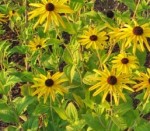 The moisture conditions in a rain garden vary and four regions can be identified: areas with 1. shallow water most of the time, 2.wet soil with occasional standing water, 3. moist but not wet soil, and 4. dry, well-drained soils. Each area has plants that will thrive or tolerate the moisture regime but few plants do well in all of them. For color in summer, the following plants are good choices for wet areas with occasional standing water. Although none tolerate permanent standing water, most will do well in moist soil as well as wet and this has been noted in the descriptions.
The moisture conditions in a rain garden vary and four regions can be identified: areas with 1. shallow water most of the time, 2.wet soil with occasional standing water, 3. moist but not wet soil, and 4. dry, well-drained soils. Each area has plants that will thrive or tolerate the moisture regime but few plants do well in all of them. For color in summer, the following plants are good choices for wet areas with occasional standing water. Although none tolerate permanent standing water, most will do well in moist soil as well as wet and this has been noted in the descriptions.
Swamp Milkweed (Asclepias incarnata)
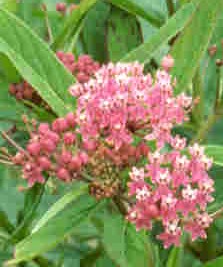 This clump-forming perennial is native to the US and can be found growing in river, wet meadows, and swamps in the from the East Coast through the central states. Branching stems carry umbels of small, fragrant, pink to mauve, occasionally white flowers ¼ inch wide that give rise to attractive seed pods up to four inches long and containing an abundance of seeds with silver-white silky hairs for wind disemination. The lanceolate leaves are three to six inches long. Flowers attract butterflies and the leaves are a source of food for larval Monarchs.
This clump-forming perennial is native to the US and can be found growing in river, wet meadows, and swamps in the from the East Coast through the central states. Branching stems carry umbels of small, fragrant, pink to mauve, occasionally white flowers ¼ inch wide that give rise to attractive seed pods up to four inches long and containing an abundance of seeds with silver-white silky hairs for wind disemination. The lanceolate leaves are three to six inches long. Flowers attract butterflies and the leaves are a source of food for larval Monarchs.
Height: 4-5’
Bloom Time: Early to mid-summer
Light: Sun to part shade
Soil: Wet to moist
Hardiness: Zones 3-6
Cardinal Flower (Lobelia cardinalis)
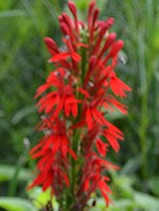 Growing in moist wet and moist locations such as in swamps and along streams throughout a large part of the US, this short-lived, clump-forming perennial has unbranched stems carrying two foot long terminal racemes of bright red, occasionally white or rose, tubular, two-lipped flowers 1.5 inches long. The lanceolate leaves are dark green, up to four inches long, and are irregularly toothed. Attracts hummingbirds and butterflies.
Growing in moist wet and moist locations such as in swamps and along streams throughout a large part of the US, this short-lived, clump-forming perennial has unbranched stems carrying two foot long terminal racemes of bright red, occasionally white or rose, tubular, two-lipped flowers 1.5 inches long. The lanceolate leaves are dark green, up to four inches long, and are irregularly toothed. Attracts hummingbirds and butterflies.
Height: 2-4’
Bloom Time: Late summer into fall
Light: Part shade in the South, full sun in the North
Soil: Moist to wet
Hardiness: Zones 3-9
Blue Cardinal Flower (Lobelia siphilitica)
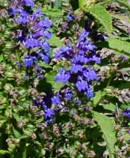 Native to eastern and central US, blue cardinal flower is a short-lived perennial and grows in wet locations such as in swamps along streams, and in low wooded areas. Unbranched stems carry leafy terminal racemes of one inch long, tubular, two-lipped, blue flowers that persist for about four weeks. The narrow leaves are three to five inches long .
Native to eastern and central US, blue cardinal flower is a short-lived perennial and grows in wet locations such as in swamps along streams, and in low wooded areas. Unbranched stems carry leafy terminal racemes of one inch long, tubular, two-lipped, blue flowers that persist for about four weeks. The narrow leaves are three to five inches long .
Height: 2-3’
Bloom Time: Late summer into fall
Light: Part shade in South, full sun in the Northt
Soil: Wet to Moist
Hardiness: Zones 4-9
Tall Cone Flower (Rudbeckia laciniata)
Tall coneflower is a long-lived perennial native to eastern and central US to the Rocky Mountains where it grows in moist soil  in woodlands and near bodies of water. It is a coarse vigorous plant with sandpaper-textured branched stems and pinnate leaves with three to five deep lobes. The daisy like flower heads are 3.5 inches across and have reflexed yellow ray flowers around a raised center of green disc flowers.
in woodlands and near bodies of water. It is a coarse vigorous plant with sandpaper-textured branched stems and pinnate leaves with three to five deep lobes. The daisy like flower heads are 3.5 inches across and have reflexed yellow ray flowers around a raised center of green disc flowers.
Height: 2-9’
Bloom Time: Summer
Light: Full sun
Soil: Moist to wet
Hardiness: Zones 3-6
Blue Vervain (Verbena hastata)
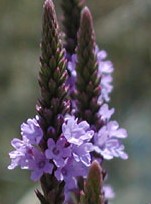 Blue vervain can be found in marshes, wet meadows, river bottoms, stream banks and waste areas in every state across the US. It has square, hairy, branched stems that carry candelabra-like inflorescence of two to six inch long densely packed spikes of purple-blue flowers. The tubular flowers are 1/8 inch wide and bloom a few at a time from bottom to top over a long bloom time. The lanceolate leaves are up to six inches long and lobed and/or sharply toothed. Bumble bees are important pollinators.
Blue vervain can be found in marshes, wet meadows, river bottoms, stream banks and waste areas in every state across the US. It has square, hairy, branched stems that carry candelabra-like inflorescence of two to six inch long densely packed spikes of purple-blue flowers. The tubular flowers are 1/8 inch wide and bloom a few at a time from bottom to top over a long bloom time. The lanceolate leaves are up to six inches long and lobed and/or sharply toothed. Bumble bees are important pollinators.
Height: 2-6
Bloom Time: Mid to late summer
Light: Sun
Soil: Moist to wet
Hardiness: Zones 3-8
False Aster (Boltonia asteroides
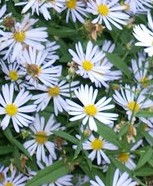 A native of eastern and central US, false aster is a rhizomaceous perennial found growing in wet fields, floodplains, shorelines, marshes, and ditches. It produces a plethora of small daisy-like flowers ¾ to one inch wide in terminal large billowy panicles. The leaves are blue-green and three to five inches long. Plants tend to get floppy and may need staking especially if grown in too much shade or fertile, moist soil.
A native of eastern and central US, false aster is a rhizomaceous perennial found growing in wet fields, floodplains, shorelines, marshes, and ditches. It produces a plethora of small daisy-like flowers ¾ to one inch wide in terminal large billowy panicles. The leaves are blue-green and three to five inches long. Plants tend to get floppy and may need staking especially if grown in too much shade or fertile, moist soil.
Height: 3-5’
Bloom Time: Late summer into fall
Light: Full sun
Soil: Moist to wet
Hardiness: Zones 6-10